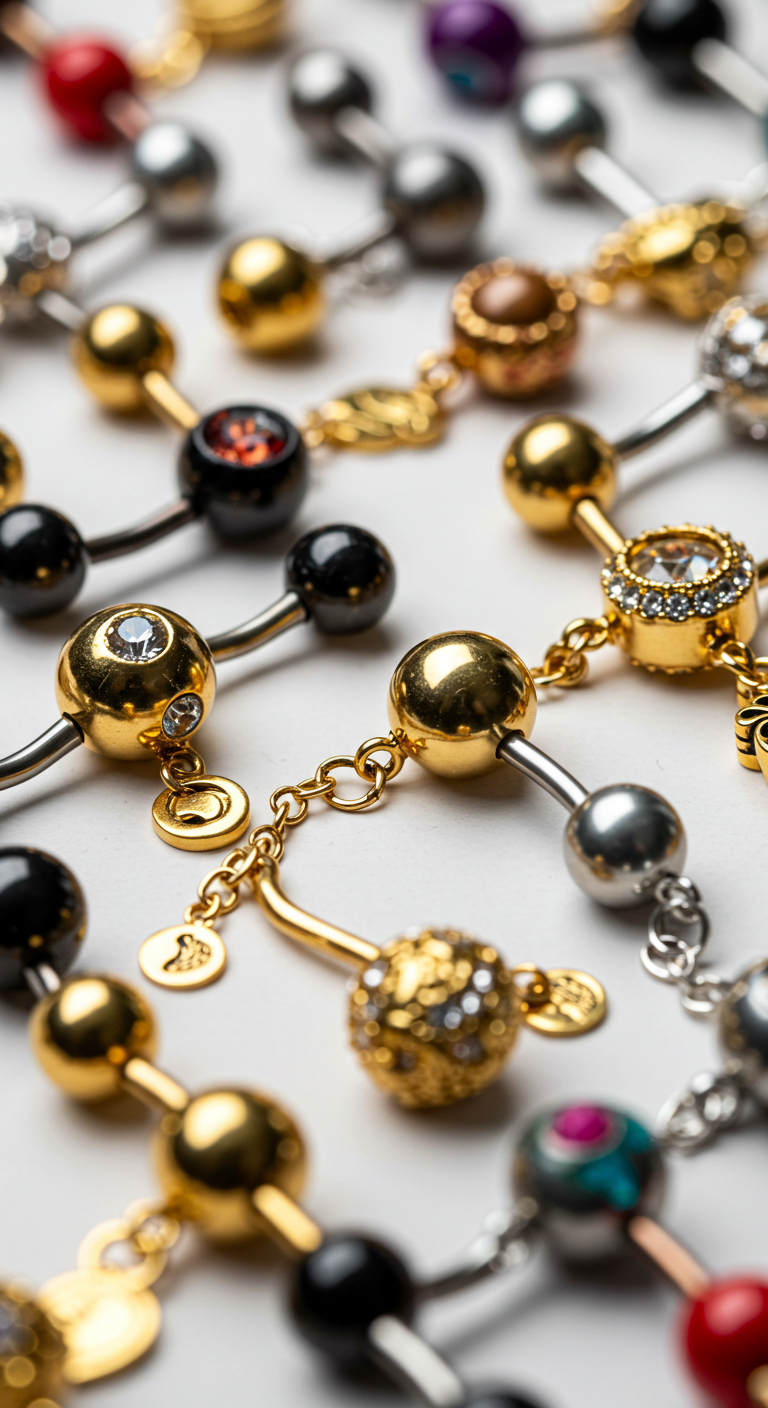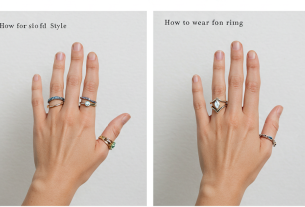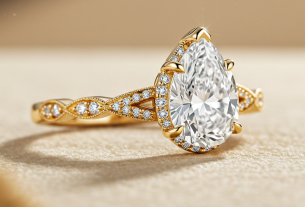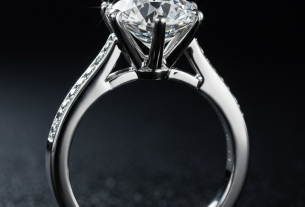The Ultimate Guide to Belly Button Rings: A Comprehensive Exploration of Style, Care, and Trends
Body piercings have long been a way for individuals to express themselves, and among the most popular and visually striking forms of body jewelry is the belly button ring. These small yet bold accessories have evolved from a trend to a mainstay in the world of fashion and body art. Whether you’re considering getting your first belly button piercing or are looking to enhance your collection with new styles, this guide will provide everything you need to know about belly button rings, from choosing the right one to proper care and maintenance.
In this comprehensive guide, I’ll dive deep into the different types of belly button rings, the materials used, the popular styles, and how to take care of your piercing. By the end of this article, you’ll have a clear understanding of how to rock your belly button ring with confidence, while also ensuring its longevity and comfort.
The History of Belly Button Rings
The belly button ring, like many forms of body jewelry, traces its roots back to ancient cultures. Piercing of the navel is believed to have originated in India, where navel piercings were not only a cultural symbol but also a sign of wealth and beauty. In other cultures, belly button piercings have been used to symbolize spiritual significance and have long been a part of traditional adornments.
However, it wasn’t until the 1990s, particularly with the rise of the “cool” rebellious spirit of youth culture, that belly button rings truly became a mainstream fashion trend. Celebrities, such as Christina Aguilera, Britney Spears, and other pop icons, helped bring navel piercings into the spotlight, and soon after, they became a staple of fashion among young people around the world.
Over the years, belly button rings have evolved from a simple piercing to a form of self-expression, with countless variations in designs, materials, and customization options available. Today, they are worn by people of all ages and backgrounds and remain a timeless and iconic piece of body jewelry.
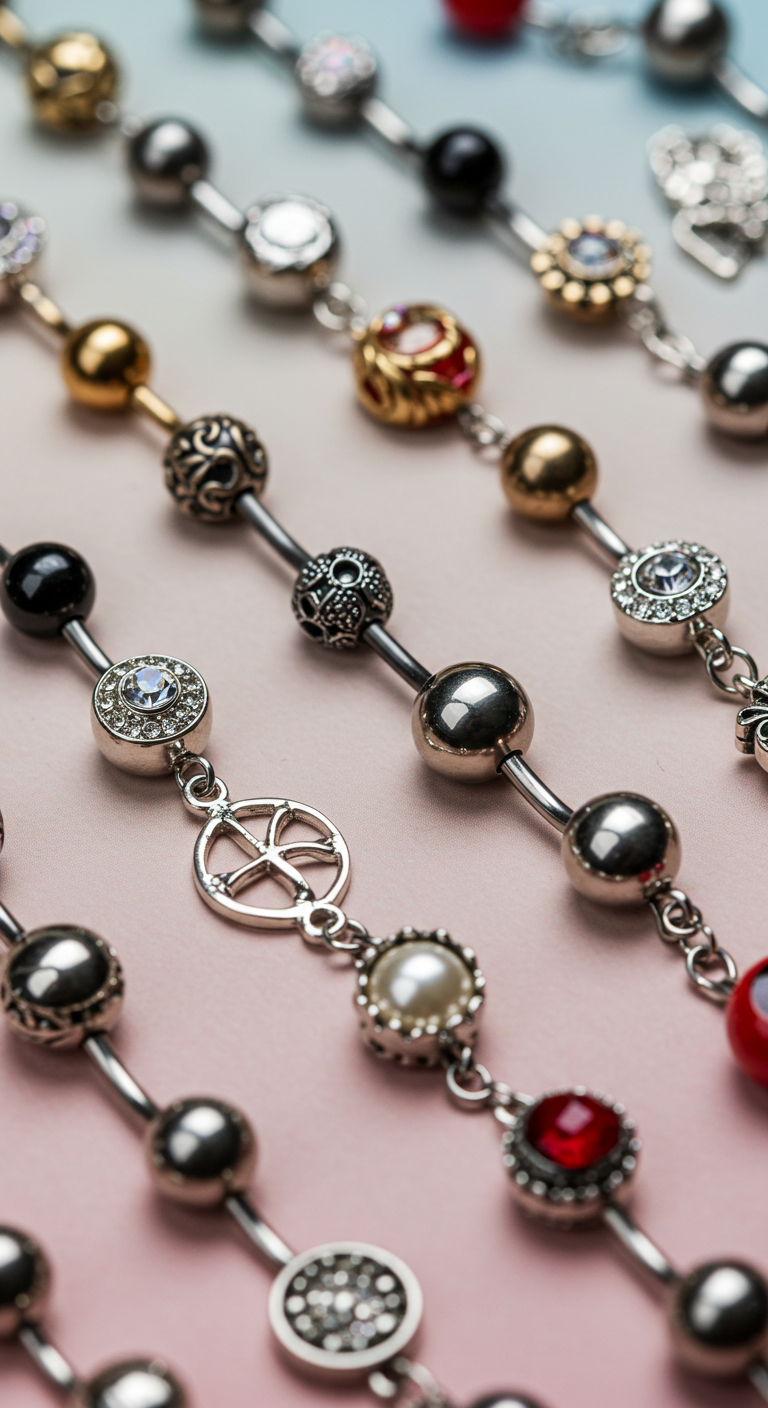
Different Types of Belly Button Rings
Belly button rings come in a wide variety of styles, shapes, and sizes. Each type offers its unique aesthetic appeal and can be chosen to fit your personal style. Whether you’re looking for something subtle and elegant or bold and flashy, there’s a belly button ring to suit every taste.
1. Curved Barbell Belly Button Rings
The curved barbell is the most common and traditional type of belly button ring. It consists of a curved metal bar with a ball on each end, typically one of which can be unscrewed to allow for easy insertion and removal. The curved design helps the ring sit comfortably in the natural curve of the belly button.
These rings come in various materials such as titanium, surgical steel, and gold, and they often serve as the base for many different types of adornments. The curved barbell is highly versatile, with endless customization options that include gems, crystals, and designs that suit different styles, from minimalist to extravagant.
2. Banana Barbell Rings
Similar to the curved barbell, the banana barbell is specifically designed for the belly button. The difference lies in the structure: the banana barbell has a gentle curve that makes it ideal for placement in the navel. These rings are often chosen for their comfort and fit, as they sit securely and snugly in place.
The banana barbell is typically adorned with decorative ends, such as gemstones, or more elaborate designs like hearts, stars, or even symbols like infinity signs. Whether you opt for a plain metal version or something more embellished, the banana barbell ring provides a stable and stylish option for your belly button piercing.
3. Straight Barbells
While less common for belly button piercings, straight barbells can be used as an alternative for individuals with different body shapes or who prefer a more linear aesthetic. Straight barbells feature a straight metal bar that can accommodate different decorations, such as beads or charms.
This style might not conform to the natural curve of the belly button as well as the curved barbell, but for those looking for something a bit more unique or customized, straight barbells offer an edgy and distinctive look. They are also a favorite among people who prefer more industrial-style jewelry.
4. Captive Bead Rings (CBR)
Captive bead rings are an alternative to barbells and are typically used for various piercings, including belly button piercings. The CBR features a ring with a small bead that is held in place by the tension of the ring. The bead can often be removed or swapped for different colors, stones, or designs. These rings provide a sleek, minimalist appearance while still offering an eye-catching element with the captive bead.
While less common for belly button piercings compared to barbells, the captive bead ring offers a distinctive and elegant appearance. It’s also a great choice for those who want something that looks polished yet understated.
5. Retainers for Belly Button Piercings
Belly button retainers are transparent or skin-toned rings designed to maintain the appearance of the piercing while being discreet. These are ideal for individuals who need to hide their piercing for professional reasons or during medical procedures. Though they lack the flashy appearance of traditional jewelry, they allow you to keep the piercing open without drawing attention.
Retainers can be worn for extended periods, but it’s important to note that they don’t provide the same aesthetic appeal as other types of belly button rings. However, they are highly practical and useful in specific situations.
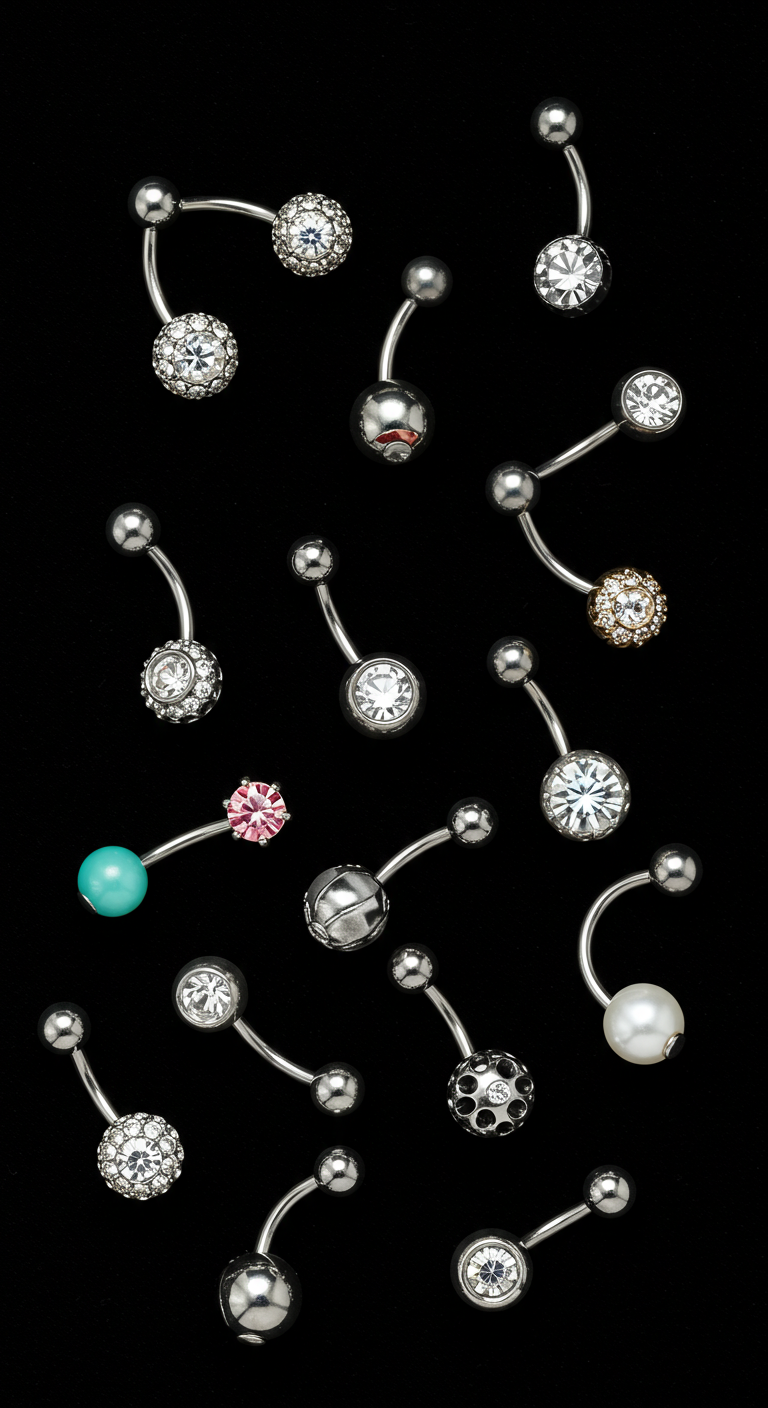
Materials Used in Belly Button Rings
When choosing a belly button ring, the material is one of the most important considerations. Different materials offer varying levels of durability, comfort, and aesthetic appeal. The right material for you will depend on your personal preferences, skin sensitivities, and style.
1. Surgical Steel
Surgical steel is one of the most popular materials used for belly button rings. It is durable, hypoallergenic, and resistant to tarnishing, making it an ideal choice for piercings. This material is also relatively affordable and comes in various finishes, from matte to shiny.
For those with sensitive skin or those who are prone to irritation, surgical steel is a safe and reliable choice. It provides a clean, polished look that complements many different styles of jewelry.
2. Titanium
Titanium is another popular material for belly button rings due to its lightweight nature and hypoallergenic properties. It is highly resistant to corrosion and is considered one of the safest metals for body piercings. Because titanium is also non-reactive, it’s an excellent option for people with sensitive skin or allergies to certain metals.
Titanium belly button rings are often found in a range of colors and finishes, including anodized options that provide an iridescent effect. This versatility in color can enhance the aesthetic appeal of your jewelry, making titanium rings a stylish and practical choice.
3. Gold
Gold belly button rings are a more luxurious option, offering a timeless aesthetic that never goes out of style. Gold rings are available in various karats and colors, such as yellow, white, and rose gold. They tend to have a rich, warm appearance that complements many skin tones.
Gold is also an excellent choice for those looking to make a statement with their jewelry. However, it’s important to note that gold belly button rings can be more expensive than other metals, and individuals with certain skin sensitivities may want to opt for higher-purity gold to avoid potential allergic reactions.
4. Bioflex and Acrylic
For those looking for flexible, lightweight options, Bioflex and acrylic belly button rings provide an alternative to traditional metals. Bioflex, a type of medical-grade plastic, is popular for initial piercings as it’s gentle on the skin and promotes quicker healing. Acrylic rings are another affordable and lightweight option, available in a wide range of colors and designs.
While these materials are suitable for healing and general wear, they are not as durable or long-lasting as metal rings and may not provide the same luxurious appearance. However, they are a popular choice for those who want to experiment with bold colors and designs.
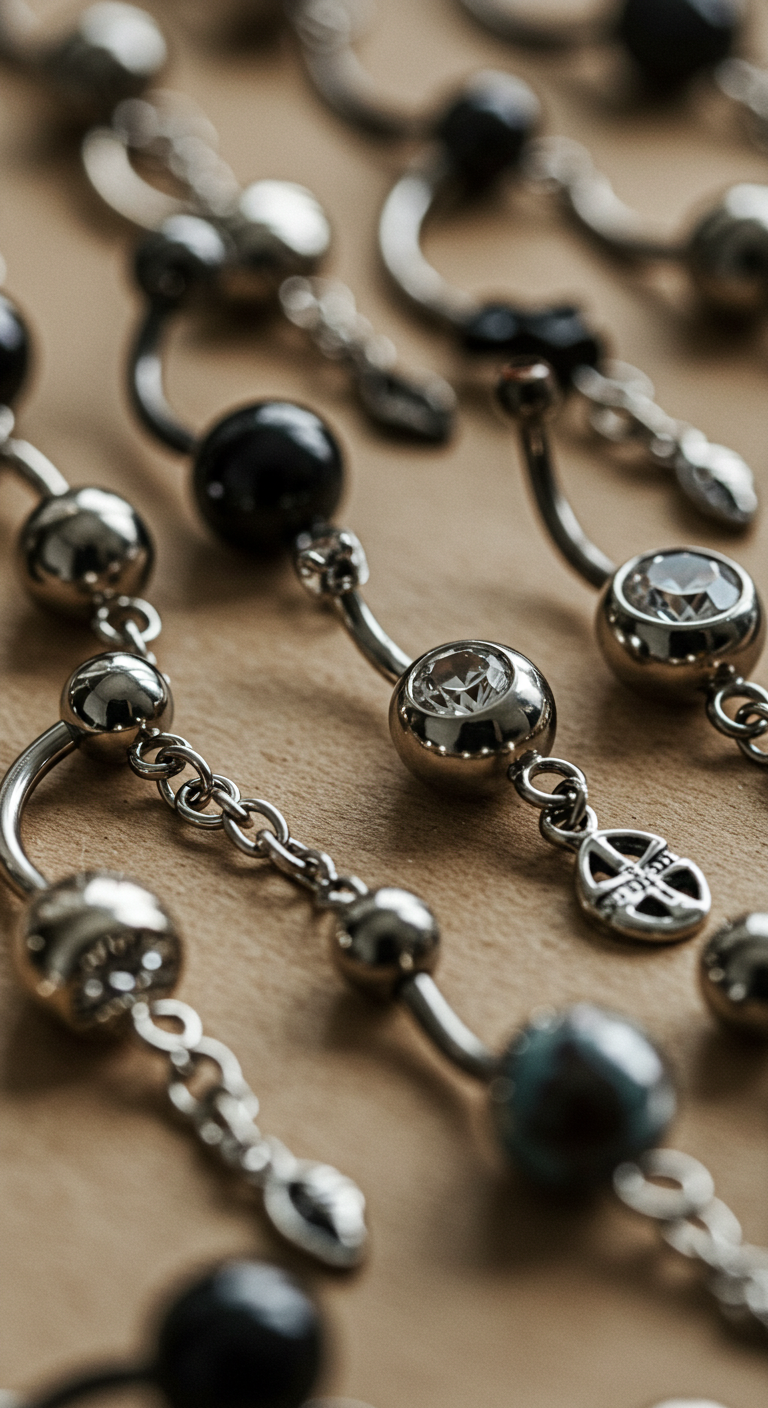
Choosing the Right Belly Button Ring
With so many options available, choosing the right belly button ring can seem overwhelming. Here are some key considerations to help you make the best decision:
- Comfort: Ensure that the ring fits comfortably in your piercing without being too tight or too loose. Rings that are too tight can cause irritation, while those that are too loose may fall out.
- Material: Consider any skin sensitivities or allergies when selecting a material. Surgical steel, titanium, and gold are safe and durable options, while Bioflex and acrylic are ideal for initial piercings.
- Style: Belly button rings come in a variety of designs, from simple and understated to bold and elaborate. Think about your personal style and how the ring will complement your wardrobe and overall look.
- Occasion: For everyday wear, you might prefer a subtle, classic design, while for special events, you might choose something more glamorous and eye-catching.
How to Care for Your Belly Button Piercing
Proper care of your belly button piercing is essential for ensuring it heals properly and stays free of infection. Here are some important tips for caring for your belly button piercing:
- Cleaning: Clean your piercing regularly using a saline solution or an antiseptic solution recommended by your piercer. Avoid using harsh chemicals or alcohol, as they can dry out the piercing and slow healing.
- Avoid Touching: Try not to touch the piercing with dirty hands, as bacteria can easily transfer to the site and cause infections. Always wash your hands before handling the jewelry.
- Avoid Swimming: For the first few months, avoid swimming in pools, hot tubs, or other bodies of water, as they may introduce bacteria into the piercing.
- Healing Time: Belly button piercings typically take 6-12 months to fully heal. Be patient and allow your piercing time to heal properly before changing the jewelry.
- Monitor for Infection: Keep an eye out for signs of infection, such as redness, swelling, or discharge. If you suspect an infection, seek advice from a professional piercer or healthcare provider.
Conclusion: The Beauty and Versatility of Belly Button Rings
Belly button rings are more than just a trend—they are a timeless form of self-expression that can enhance your personal style and confidence. With a wide range of designs, materials, and customization options, there is a belly button ring for everyone, whether you’re looking for something subtle or a piece that makes a bold statement.
By taking care of your piercing and choosing the right ring for your style and preferences, you can ensure that your belly button ring remains a beautiful and lasting accessory for years to come. Whether you’re rocking a classic barbell or experimenting with a more intricate design, belly button rings are here to stay, offering endless possibilities for self-expression and style.
Lcherry Faith Cross Pendant Necklace for Women Religious Christian Jewelry Mother's Day Gifts for Women
$12.73 (as of May 15, 2025 03:05 GMT -03:00 - More infoProduct prices and availability are accurate as of the date/time indicated and are subject to change. Any price and availability information displayed on [relevant Amazon Site(s), as applicable] at the time of purchase will apply to the purchase of this product.)
Receive tips, news and exclusive offers! Sign up for our newsletter now!


